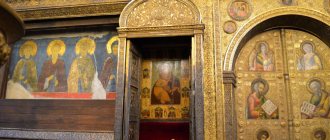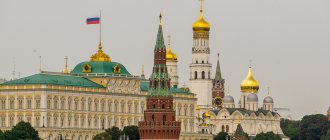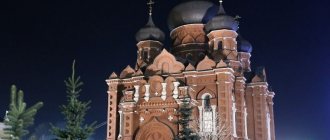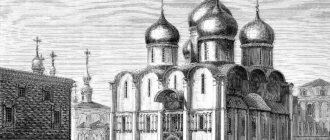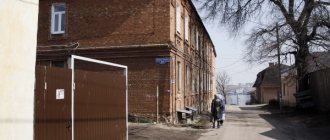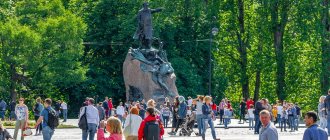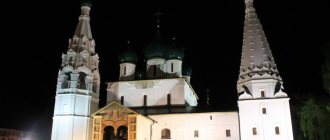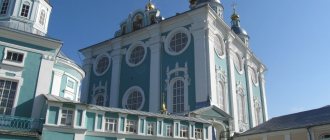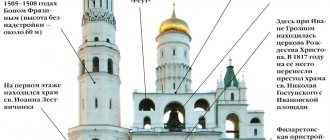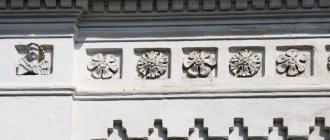The main temple of the Russian state - this is the official status that the Assumption Cathedral, located on the current territory of the Moscow Kremlin, had for almost four centuries. Its importance for the spiritual life of our country was not underestimated even after the country became the Russian Empire and the capital was moved to St. Petersburg. The Assumption Cathedral continued to be the place of coronation of absolutely all Russian emperors, starting with Peter II.
Question and answer From oak to brick: how has the Moscow Kremlin changed? Infographics
On April 30, 2015, the Assumption Cathedral, as we know it today, celebrates its 544th anniversary since the laying of the first stone in 1471. However, the first churches on this very site appeared long before the Assumption Cathedral acquired its current appearance.
Cathedral of Christ the Savior in Moscow
Cathedral of Christ the Savior
Moscow
Temple as a sign of gratitude. The main cathedral of the Russian Orthodox Church, the Cathedral of Christ the Savior, was built in honor of the victory of the Russian people over Napoleon's troops. Construction took almost half a century, and on June 7, 1883, according to the new style, the cathedral was consecrated. In December 1931, the temple-monument to military glory was destroyed by explosion, and in 2000 the cathedral was built again. Just like the main cathedral in Russia, many temples collapsed and were rebuilt from ruins. But they survived, although they lost most of their shrines.
There will be a temple
After a natural disaster, Ivan III decided to change the architect and invited from Italy the famous architect of that time, Aristotle Fiorovanti , who completely dismantled the remains of the existing building and began construction of a new temple - in the image and likeness of the already existing Assumption Cathedral in Vladimir.
Construction was completed in 1479, when the cathedral was consecrated by Metropolitan George . The temple turned out to be truly huge for Moscow, which had never seen such large-scale stone structures before. Since then, the temple has survived almost unchanged to the present day - a six-pillar, five-domed, five-apse cathedral.
The main painting of the temple took place at the end of the 15th – beginning of the 16th centuries. icon painter Dionysius took part in it . However, almost a century and a half later, the cathedral was painted again. True, in some places there are still fragments of the original painting, which today are unique monuments of ancient fresco painting on the territory of the Moscow Kremlin.
Assumption Cathedral. View from the south. Photo: Commons.wikimedia.org
The first royal crowning in this cathedral took place almost half a century after the laying of the first stone - in 1547, Ivan IV , later nicknamed the Terrible, was crowned king. Mikhail Fedorovich was elected sovereign of all Russia in 1613 - it was here that the history of the royal family of the Romanovs, who ruled Russia until the revolution of 1917, when the Bolsheviks came to power, began.
During this time, the temple experienced many misfortunes - it often suffered from fires, after each of which it was awaited renovation or complete restoration. In 1547, after one of these fires, the domes of the cathedral were renewed - with gilded copper sheets. So Moscow became golden-domed.
The temple suffered the greatest damage in 1812, when its walls were desecrated by soldiers of Napoleon's . The building itself was once again set on fire, and all the treasures, including Orthodox relics, were taken away by the French. True, many valuables were saved even earlier by evacuating them to Vologda.
Reproduction of the painting “The French in the Assumption Cathedral in Moscow” by Vasily Vasilyevich Vereshchagin. State Historical Museum. Photo: RIA Novosti
Epiphany Cathedral in Elokhov in Moscow
Epiphany Cathedral in Elokhov in Moscow
Moscow
The temple in which Alexander Sergeevich Pushkin was baptized. Since 1938, the cathedral became a cathedral, and then the Patriarchal. From 1943 to 1991, the enthronement of the primates of the church - the patriarchs - took place here. They were either going to demolish the temple and expand Elokhinskaya Square, or they were going to make it a house of rare books or a cinema. But to this day, the cathedral remains a cathedral for the Moscow Patriarchate and preserves shrines: the icon “Cathedral of the Mother of God”, depicting 164 images of the Mother of God, the relics of St. Alexy of Moscow - one of the mentors of Dmitry Donskoy. The surroundings of Spartakovskaya Square in Moscow are echoed by the ringing of 17 bells that have been preserved since the 19th century.
From wood to white stone
The temple stood on the current site of the Assumption Cathedral almost from the moment of its foundation. But only in the 14th century, during the reign of Ivan I , the wooden cathedral was replaced by a stone one, which became the first stone church in all of Moscow.
The walls of the Cathedral of the Assumption of the Blessed Virgin Mary, built in 1326–1327, were made of white stone. This four-pillar, three-apse, three-aisle, single-domed temple was modeled after St. George's Cathedral, located in the city of Yuryev-Polsky, in the Vladimir region. Crowned with kokoshniks characteristic of the architecture of that time, the temple was laid out with rough masonry from squares of white stone, interspersed with smooth-hewn elements of architectural decor.
Assumption Cathedral in the 19th century. Painting by Henry Charles Brewer. Photo: Commons.wikimedia.org
However, towards the end of the 15th century, the temple became dilapidated and required reconstruction - the vaults had to be supported with scaffolding, and the roof kept threatening to collapse. And both in its architecture and in its size the temple ceased to correspond to the status of the main cathedral of the growing Moscow state.
“Metropolitan Philip began to earnestly think about building a new stone cathedral church in Moscow, for the old one, built by Kalita, was already in danger of destruction from antiquity and from many fires, its vaults were already reinforced, supported by thick trees,” says the chronicle, dated approximately 1471 year.
Assumption Cathedral in Smolensk
Assumption Cathedral in Smolensk
Smolensk
One of the most revered churches in Russia was built in memory of the heroic defense of the city from the troops of the Polish-Lithuanian Commonwealth. The temple on Cathedral Hill was founded by Vladimir Monomakh, but that church could not withstand the assault. The new cathedral took about a hundred years to build. Miraculously, the church survived the invasion of Napoleon, lost the helmet of the patron saint of Smolensk - Saint Mercury, but the Smolensk partisans recaptured the shroud donated by the Moscow Kremlin from the French. During the Great Patriotic War, the cathedral lost its main shrine - the Smolensk Icon of the Mother of God "Hodegetria", which came to Rus' in the 11th century. Now the cathedral houses an image of Hodegetria from the 17th century, copied from a miraculous icon under Tsar Ivan the Terrible.
Memorial "Road of Memory"
The Main Cathedral of the Russian Armed Forces is surrounded on all sides by the “Road of Memory” multimedia gallery. The length of its exhibition galleries is 1418 steps, which corresponds to the number of days of the Second World War. In chronological order, the memory of millions of victims is immortalized here, every day of wartime and key battles are told, starting with the treacherous attack on the USSR by Nazi Germany on June 22, 1941 and ending with Victory on May 9, 1945.
Of interest are 174 memorial plates with brass sleeves placed in them (about 15 thousand). The latter are filled with earth brought from mass graves and water from the sites of the sinking of military ships.
Opposite the temple there is a 9-meter figure of the grieving Mother of the Winners. With her mantle she covers the Candle of Memory, lit from the Eternal Flame in the Alexander Garden in Moscow.
Memory Road, © Irina Dementieva
"Victory Field"
The open-air museum is presented as a collective image of the battles with the Nazis near Moscow in 1941. Several thematic zones were created based on front-line photographs and archival records.
Cathedral of Equal-to-the-Apostles Prince Vladimir in Astrakhan
Cathedral of Equal-to-the-Apostles Prince Vladimir in…
Astrakhan region
The temple built in honor of the 900th anniversary of the Baptism of Rus'. A church was erected on the border of Russian and Tatar settlements for missionary purposes - to introduce Muslim Tatars to Orthodoxy. One of the chapels of the temple is St. Nicholas, who was revered even by Muslims, and most importantly by the sailors who lived in large numbers on the Astrakhan lands. According to legend, the cross was built from a cast iron anchor. The cathedral suffered many disasters. The temple has been a warehouse and a bus station. In 1919, warships shot at the church at point-blank range. According to legend, the fire stopped after the appearance of the face of the Virgin Mary on the dome of the cathedral. Among the especially revered shrines, especially by sailors, is the icon “St. Nicholas on the Waters,” donated by Admiral Vladimir Masorin.
Church of the Transfiguration of the Lord on Fr. Kizhi
The wooden octagonal church on the island of Kizhi was built at the beginning of the 18th century and is now in deplorable condition. Architectural experts insist on its complete reconstruction, but cannot decide how to do this.
Well, while they are arguing, tourists going to the island to admire the 22-domed church are risking their health by approaching the emergency building.
Cathedral of the Icon of the Mother of God “The Sign” in the Znamensky Monastery in Kursk
Cathedral of the Icon of the Mother of God of the Sign in the Znamensky Monastery in…
Kursk region
Temple on the site of the city fortress. In 1612, the city was captured and devastated by Polish-Lithuanian troops. Only the citadel remained impregnable. In memory of the events, the monastery of the Kursk Icon of the Mother of God “The Sign” was built. Construction of the Znamensky Cathedral began in 1816. After the revolution, the “October” cinema was located in the majestic temple; the miraculous icon was taken out of the country by the Volunteer Army and ended up in the USA. Only in the 90s of the 20th century the temple became a cathedral, and among the shrines there appeared a copy of the image “The Sign”, written in 1902 by the monks of the Znamensky Monastery.
Kazan Cathedral
Kazan Cathedral
Saint Petersburg
A temple built on a historical site - instead of the court church of the Nativity of the Blessed Virgin Mary. Time and dampness damaged the wooden baroque, and Paul I decided to build a temple not inferior in grandeur to the Vatican's St. Peter's Cathedral. They demolished 11 houses on Nevsky and began to build according to the design of the former Stroganov serf Andrei Voronikhin. The cathedral became the legal successor of the demolished church. The tradition of honoring the Russian army after military victories has been preserved. Even the iconostasis of the cathedral is made from trophies - 40 pounds of trophy silver were spent on the cladding. The main shrine of the cathedral is a copy of the Kazan Icon of the Mother of God, Tsarina Praskovya Feodorovna, which came to St. Petersburg after the capital was moved in 1712.
Holy Assumption Cathedral in Makhachkala
Holy Assumption Cathedral in Makhachkala
The Republic of Dagestan
The main Orthodox church in the capital of Dagestan. Built in 1906 with donations from residents of the village of Port-Petrovsk, as Makhachkala was formerly called, and money from Nicholas II. It was consecrated in honor of the patroness of the Caucasus - the icon of the Iveron Mother of God. In the 90s of the twentieth century, the temple was practically empty, at that time Russian-speaking Makhachkala residents were leaving the city. But twenty years later, a new chapel was built in the temple in honor of Alexander Nevsky, and the vaults were painted anew. All the wall painting was carried out by local Muslim craftsmen under the guidance of the famous Dagestan artist Abdulzagir Musaev. The main shrine of the temple is copies of the gifts of the Magi from the Greek monastery of St. Paul.
St. Catherine's Cathedral
St. Catherine's Cathedral
Krasnodar
The main temple of the Ekaterinodar and Kuban diocese, one of the largest in Russia. Construction of the temple began after the crash of the royal train, on which Alexander III was returning from a trip to southern Russia. The entire royal family remained unharmed, and the local City Duma decided to build a temple in honor of this event. They built it conscientiously, and this saved the temple in the 30s. Egg white was used in the brickwork, and the cathedral was not blown up for fear of destroying the surrounding neighborhoods. The architect Ivan Malgerb also deserves credit for this. In 1944, the chapels of the cathedral were consecrated again, but no longer in honor of the heavenly patrons of members of the royal family. The main shrines of the temple are the relics of the Great Martyr Catherine and the Blessed Matrona of Moscow.
Novocherkassk Holy Ascension Cathedral
Novocherkassk Holy Ascension Cathedral
Novocherkassk
The main temple of the Don Cossack Army. Opened and consecrated in 1905. The cathedral is the seventh-highest dome in Russia. The cross is inlaid with 80 monoliths of rock crystal; because of its reflections, the temple is called “the second sun of the Don.” In the lower church lie the remains of the founder of the capital of the Don Cossacks, the “Whirlwind Ataman” Matvey Platov. In the 1930s, the gilded copper sheets were removed from the domes and the cathedral was turned into a storage facility for fuel oil. But 20 years later, thanks to historians, the temple began to be restored. Among the many shrines of the cathedral, the icon of the Assumption of the Mother of God, donated to the Don army at the end of the 19th century by Metropolitan Platon of Kyiv and Galicia, has survived.
Architecture
The monumental building is made in the Russian-Byzantine style using modern techniques of Orthodox temple architecture. The stone facades are decorated with numerous carved reliefs and covered with metal sheets, skillfully decorated with patina. Bronze sculptural groups are organically intertwined with the image of a warrior-defender.
The cathedral stands on 435 15-meter stilts. The porch steps and ramps are cast from melted down captured Wehrmacht military equipment with the addition of cast iron.
Lower Temple, © Irina Dementieva
The church is divided into two tiers. In the upper temple there are 4 chapels - the prophet Elijah, the Great Martyr Barbara, Andrew the First-Created and Alexander Nevsky. A three-level bell tower is attached to the temple from the west. The author of the project is the architect D. Smirnov.
The complex occupies an area of 11 thousand square meters. m. It can simultaneously accommodate up to 6 thousand people. Dimensions of the building in plan:
- length - 97.6 m;
- width - 65.4 m.
Domes
The temple is crowned with gilded domes - central, 4 corner and bell. The largest one was erected over the middle cross in November 2019, its weight is 80 tons, and its size in plan and height is 12 m each. The mass of others is 34 tons each. A month later, Orthodox crosses made in monumental style were installed on all 6 domes Russian style and decorated with enamel inserts.
© bbcvdv0229
Bells
The belfry contains 18 bells weighing from 8 kg to 10 tons and a total weight of 20 tons. They were cast at the Voronezh Industrial Casting Plant according to specially designed bas-relief sketches. On the main bell - the “evangelist” - important events of the Second World War are symbolically depicted, and on each of the other 17 there are emblems of different branches of the military, as well as their corresponding heavenly patrons.
The Main Church of the Armed Forces in the Moscow region found its “voice” on August 23, 2021, when those present at the solemn ceremony of consecrating the bells heard the ringing of the “evangelist.”
Symbols
Several important dates and numbers are encrypted in the building of the Church of the Resurrection of Christ.
- 75 m (75 years of Victory) - the height of the bell tower.
- 1418 cm (1418 days of WWII) - the height of the small dome.
- 1945 cm (1945 Victory) - the diameter of the light lantern of the main dome.
- 8 windows (the Act of Unconditional Surrender was signed on May 8) - the number of openings on the main light drum.
- 22.43 m (22:43 hours - time of signing the Act) - diameter of the central dome.
The height of the temple - 96 m - is associated with the year of birth of Prince Vladimir (presumably 956–58), who converted to Christianity and baptized Rus'.
Inside the temple: Google panorama
All Saints Cathedral in Tula
All Saints Cathedral in Tula
Tula region
A snow-white 18th-century temple in the style of Russian classicism appeared in the ancient city after the plague epidemic. The cemeteries were moved outside the city walls, and in 1776, a cathedral was built at the All Saints Necropolis with merchant money. The icons for the one-story church were created by the icon painter and Tula gunsmith Grigory Belousov. In 1859, the architectural ensemble was complemented by an 82-meter bell tower with trumpeting angels - a gift from the church warden, merchant Pirozhnikov. But the first bells were stolen, and the guards were beaten with rods for negligence. The consecration of the bell tower took place four years later. Particularly revered in the church are the Athonite Icon of the Mother of God “Merciful”, the Kazan Icon and the Icon of St. Nicholas with a particle of his relics.
Epiphany Cathedral of Tomsk
Epiphany Cathedral in Tomsk
Tomsk
The temple in the Siberian Baroque style was built on the site of the Epiphany Church built in 1630. It is significant because in 1804, in an unfinished cathedral, without a roof, the governor publicly announced the creation of the Tomsk province. The post-revolutionary history of the temple is similar to many. Sibzheldorstroy courses, a vermicelli factory, etc. were opened in the cathedral. Only by the 21st century was the dilapidated cathedral restored to its historical appearance. The greatest shrine of the temple and the entire city is the image of the Life-Giving Trinity, with which Boris Godunov blessed the Cossacks for the founding of the Tomsk fortress. The icon itself, made by Andrei Rublev, was lost during Soviet times, but its exact copy was presented to the temple for the 400th anniversary of Tomsk.
Church of the Intercession on the Nerl
Founded in 1165, the modest temple above the river is widely known for its exquisite beauty, simplicity and grace of form. Unlike the magnificent temples of the capital, it is small, not covered with carvings and patterns, but is valued by historians and artists.
The reflection of the temple in the water of a quiet river has been depicted and photographed thousands of times and never ceases to attract tourists who are not lazy to walk a couple of kilometers from the nearest village to admire the temple at sunset and dawn.
